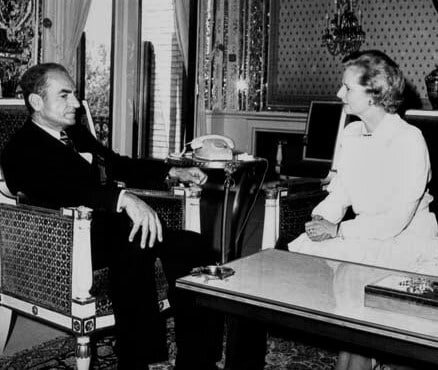Tehran – 47 years ago, in April 1978, Margaret Thatcher, the leader of the British opposition Conservative Party, visited Iran almost a year before the Islamic Revolution. She discussed with Mohammad Reza Shah and shrouded him to buy more British-made weapons and military equipment to create jobs in his country amidst the economic recession.
During his visit to Iran, Thatcher described Mohammad Reza as “one of the world’s most myopic politicians.”
Perhaps Thatcher was one of the politicians whose Shah regime relied on most of Europe. She played a major role in shaping the party’s view of Iran and the development of the world.
On a visit to Tehran in the spring of 1978, Thatcher discussed the sale of Shah and British arms to Iran and the construction of a military industrial facility near Isfahan. She said during a meeting with the Shah that the purchase of Iranian military equipment created thousands of jobs in the UK.
Looking at the history of Iran-British relations before the Islamic Revolution of 1979, it shows that the British had their hands on all internal incidents during the Shah rule, which lasted 27 years between 1941 and 1979.
The British establish the Pallavi dynasty
Britain was a foreign force that played a major role in establishing the Pallavi dynasty. A 1932 British Embassy report published by British media confirmed that the British had placed Reza Khan, Mohammad Reza’s father, on the throne.
The British were the dominant power of Iran, the Qajar dynasty, even before the Pahravi dynasty. They were putting pressure on Kajal Shah to make major concessions in the field of oil and natural resources.
Reza Khan ascended to power as war prime minister and subsequent prime minister, Qajar Shahs’s final Ahmad Shah was given with British support before the establishment of the Corner Crown and Pahlavi dynasty in 1925. During Reza Shah’s 20-year reign, Britain effectively ruled Iran and its resources after helping to establish a domestic military dictatorship in line with colonial goals.
It was the British who took Reza Shah out of power in 1941 and replaced him with his son Mohammad Reza Pallavi after hating him during World War II for suspected trends towards Germany.
During Mohammad Reza’s reign (1941-1979), Britain was behind many major developments in Iran. It was they who worked with the newly arrived Americans to perform the 1953 coup on August 19, 1953 against Mohammad Mosadegu’s democratically elected government.
The Bahrain concession of Mohammad Reza Shah in 1971 was also the job of the British. Indeed, Shah succumbed to a decade-long plot designed by the British Empire. Bahrain declared independence as a result of a false process organized by the UK.
An event that raised a popular responsiveness to Britain’s presence in Iran before and after the Islamic Revolution.
Britain’s despair after the Islamic Revolution of 1979
A few months after Thatcher’s visit to Iran in April, the British Labour Government led by Prime Minister James Callahan secretly agreed to Shah’s request to supply 175,000 CS gas cans and up to 360 armored staff carriers to the Shah administration. Among the British were Sabak, the intelligence agency of the Shah.
Ten days after the victory of the Islamic Revolution in Iran, Callahan vowed to acknowledge Iran’s interim government, Mehdi Bazagan, through Foreign Secretary David Owen. But two months later, when Thatcher took office in May, she announced that her country would rethink her perception of the new Iranian government. The announcement was the beginning of a hostile policy adopted by the new British Prime Minister during his 11-year tenure against Iran’s Islamic Republic.
However, she refused to grant political asylum to the fugitive, fearing retaliation from Iranian revolutionaries.
Meanwhile, Thatcher’s government approved the proposals of American officials regarding the need for a military attack on Iran in response to the acquisition of the US embassy in Tehran. She then accepted the US call to participate in economic sanctions against Iran, and in 1980 she expressed her support for the US Command’s Eagle Claw Operation, held in Tehran, to airlift embassy staff. The operation ended with a US disaster after a sandstorm grounded the troops and destroyed military equipment in the Tabas Desert in northeastern Iran.
A few days after the US operation failed, the siege of the Iranian embassy in London began. The group of terrorists took 26 hostages from April 30th to May 5th, including embassy staff within the compound. The siege, besieged by the British government, met some of the anti-Iranian demands from hostage trustees, including broadcasting requests on British television. Two Iranian diplomats were killed in the incident.
After Mohammad Reza Pahlavi’s death in 1970, the Thatcher government issued a statement expressing sadness in his end. There were other attacks in 1980 on Iran’s diplomatic facilities and other interests in the UK. Furthermore, in June 1984, Thatcher’s government expelled five Iranian diplomats from the UK, and met with repulsion from Iran.
Furthermore, Thatcher’s government armed Iraq during the Iran-backed war throughout the 1980s.
The British government protested diplomatic relations with Iran on March 7, 1989, against Fatwa, published by Imam Khomeini regarding the publication of British Salman Rushdi’s “The Devil’s Poem.” The Iron Lady government also launched a witch hunt campaign that year against Iranian students.

